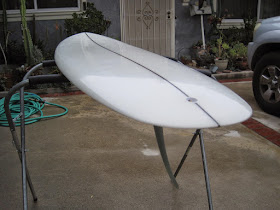But unlike Greenough's difficult-to-build glass spoon kneeboards, which were limited to perfect, empty waves...
...Lynch surfed conventionally built boards which were well-suited to everyday surf...
In spite of his untouchable level of performance in the water, Lynch still presented us with obtainable goals. We didn't need a degree in aerospace engineering to build a board like his, and we could easily find the average quality surf he expressed himself in so well.
So, 2 of the 3 components -- board and waves -- were within easy reach.
The 3rd element...world class wave riding skill? Not so much!
...and moved on to the longer, narrower downrailers...
Of the thousands of surfers who put Lynch's surfing on a pedestal in 1968-69, a few of us chose not to follow his lead as he evolved into narrow lowrailers the '70's. Our personal arc remained focused on the continuing development of hulls.
We were more successful in that pursuit than the first-gen hull shapers, but to be fair, we had several advantages:
- One, we had Fins Unlimited fin boxes to work with, so the nightmare of sorting fin shape and placement during the glass-on era was over. Changing or moving a fin -- which had been a miserable, stinking, itchy 3 hour ordeal -- became a 30 second breeze. A huge barrier to progress was removed.
 |
| (You can see that Lynch altered the fin placement on this board.) |
- Two, we had much better blanks. The forward apex, straight/relaxed tail rocker plugs of the 70's were ideal for small hulls. A 6'6'' pulled from the center of a Clark 8'1'' B blank was pretty much going to be a ripper.
- Three, we focused our design efforts on a handful of local spots. No need to design a generic, compromised board that would work at Huntington Pier one week, Honolua Bay the next.
- Four, the world wasn't watching. We weren't involved in contests and marketing, where the Hawaiian influence was dominant. All that mattered was how our equipment felt to us in the waves we rode. What a contest judge, a cameramen, or a magazine editor thought didn't effect our income or self-esteem. We were free to build and surf whatever we wanted.
Long story short, hulls flourished in the hands of a number of skilled shapers. Naturally, each builder developed boards that worked for them in their home waves, and a wide variety of good designs evolved over the next 5 decades...
That said, one shape that has always haunted hull surfers is the original Lynch 8 foot, double-ender V bottom. There was something so friendly about that design...a loose handling, quick-to-plane-out board that would rip virtually any wave under 6 feet!
Recently, a friend looking for a hull to ride junkier, less crowded surf asked me to draw up a cut file for an 8 foot Lynch double-ender. The idea was to hang onto as much as possible from the original boards, but interject the advancements developed over the years.
This is what I drew up...
The tail isn't as wide/full as the original roundtails...
...but it isn't as pulled-in as the later pintails that Lynch favored...
The tail area flattens out, with a touch of tail kick...
The back has an edge...
The hull under the nose flattens out a bit as well...
Two profile/proportion images from the cut file program. It came together nicely...
Spencer Kellogg did the great finish work on the cut blank...
It takes a knowledgeable hull shaper to sand out a milled blank, even though 95% of the work is already done. The details really matter on a hull!
The finished board...

















































Urghhh! Want one!!
ReplyDeletehttps://www.youtube.com/watch?v=0JmeZXBaUFo
Nice read!
ReplyDeleteYou've added even more content! Especially great post, Paul. I'd love to get one of your boards someday. Maybe something like proneman's.....
ReplyDeleteA beauty, Paul! And with the Spencer Kellogg touch, too. Thanks for the post.
ReplyDeleteSpeedshaper
Such a good post. The new board looks completely correct
ReplyDelete